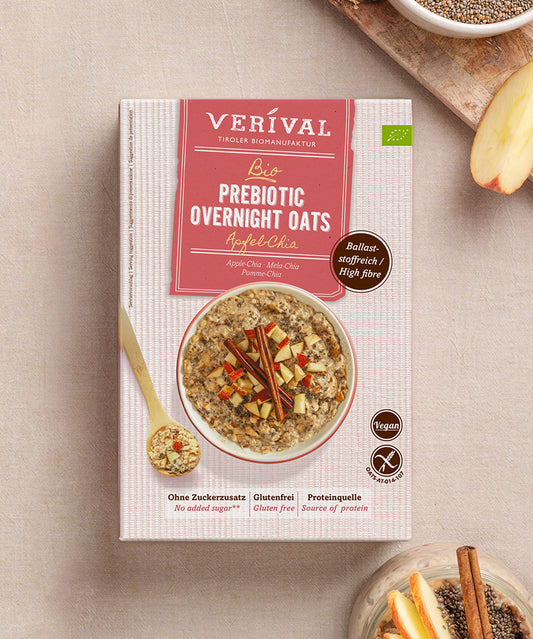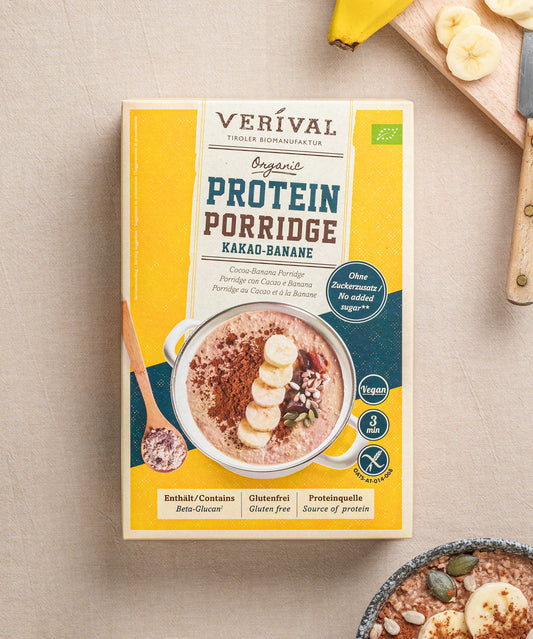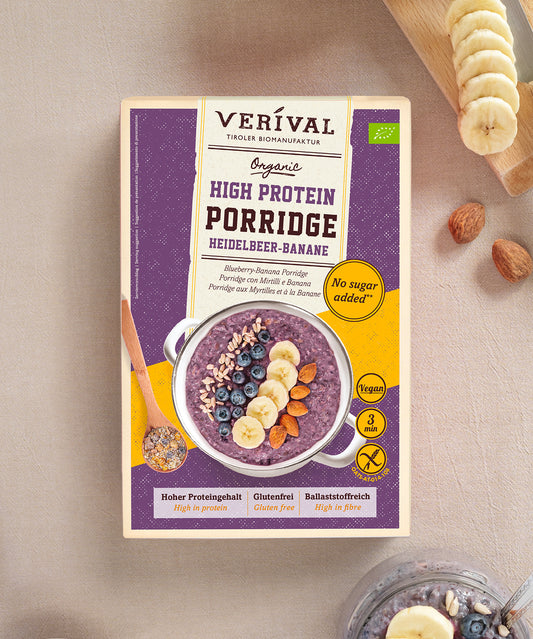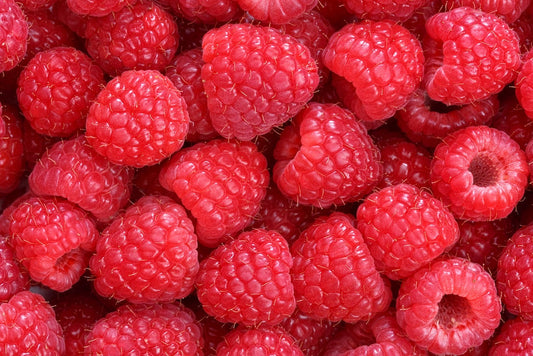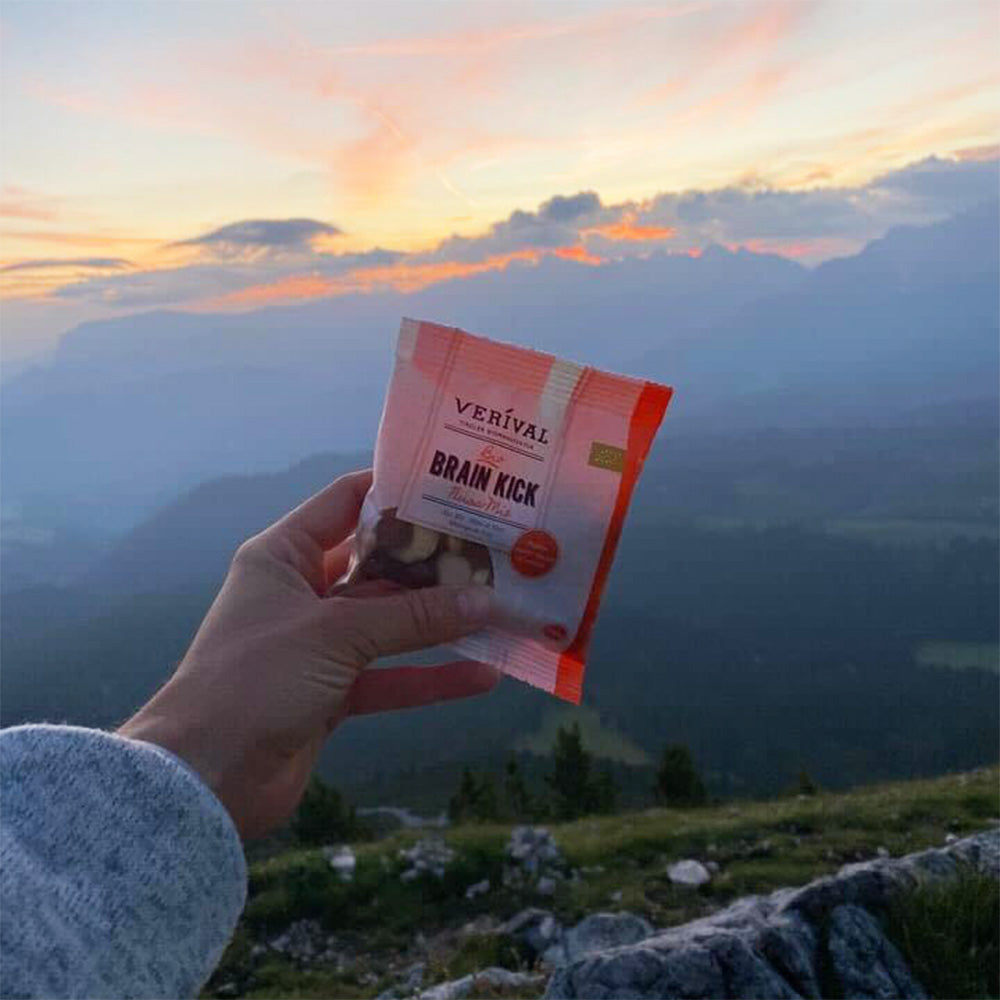Awareness of nutrition is on the rise in our society. We're sure you take the occasional look at the calories in your meals.
But have you ever looked at the calorie content of porridge? If not, then you've come to the right place – because we won't just be looking at the calorie content of porridge, but we'll also give you tips and tricks on how you can reduce or increase calories. With the Verival calorie calculator, you can calculate your calorie requirement for free.
Delicious low-calorie porridge – discover it here
How to calculate the calorie content of your porridge
The number of calories in porridge varies from variety to variety. However, if you prepare this healthy breakfast completely on your own, you should take into account all the ingredients and their energy content.
Oat flakes are the basic ingredient of most porridges. These nutritional powerhouses contain around 350 calories per 100 grams – an average portion of porridge will require around 50 grams, giving you about 175 calories.
Then there's the liquid. While classic milk with a fat content of 3.5 percent has a good 64 calories per 100 milliliters, plant-based drinks are slightly lower in calories on average. Nut drinks, for example, often only have around 10 calories per 100 milliliters, while soy milk has a good 30 to 50 calories.
If you use about twice the amount of liquid for your 50 grams of oats, you will need about 100 milliliters. Of course, depending on the consistency you want, you can use more or less liquid. However, double the amount of liquid compared to the base is usually a good reference value.
So if you use milk, you have to add another 64 calories to your 175 calories for the oats. If you use a plant-based drink or just water, you will of course get off a bit lower in calories.
However, milk already adds some sweetness to the porridge, while oats with water are likely to be somewhat neutral in flavor. So you will need some sweetness. Depending on the source you use, you can increase the calorie count as needed. For example, if you use honey, you have to expect about 60 calories per tablespoon. Agave syrup and date syrup also have a similar calorie content.
However, if you prefer to use fresh fruits such as berries, you can allow yourself a little more due to their comparatively low energy density. For example, you can eat about 100 grams of blueberries for 60 calories. Berries are not only more nutritious than the classic sweeteners, but also satisfy you better due to their larger volume. So, of course, we recommend fresh fruits.
You should expect so many calories
If you add up all the ingredients, you get the following result: 175 calories for the oats (50 grams), 64 calories for the milk (100 milliliters) and 60 calories for the sweet berries (100 grams). This adds up to exactly 300 calories for your oatmeal.
| Ingredients in oatmeal | Calories (kcal) |
| 50g oatmeal | 175 kcal |
| 100ml milk 3.5% | 60 kcal |
| 100g blueberries | 60 kcal |
| Topping of your choice | 100-150 kcal |
| Total Calories | 395-445 kcal |
The only thing missing now are the toppings. Whether seeds, nuts or crunchy granola, every porridge tastes unique. However, in addition to the flavor, you should also consider the calorie count. Nuts and seeds are calorie bombs – but you can find out why they are still healthy here.
Nevertheless, especially with toppings, less is more. A handful of nuts or seeds, for example, is enough to not only optimize the taste of your porridge, but also to add important nutrients.
Low-calorie spices for your porridge – discover them now
How many calories do I need?
However, the calorie count per meal is difficult to interpret without context. It makes much more sense to determine your own calorie needs as a reference. In summary, the average adult has a daily requirement of 1800 to 2400 calories.
If you eat three main meals and a snack a day, you can expect around 500 to 600 calories per meal. So you can add a little topping to your porridge – a handful of nuts, for example, will add another 150 calories to your meal and provide you with valuable nutrients.
To find out how many calories you should actually consume to reach your ideal weight, you can use the BMI calculator. Based on the information you enter, it calculates your BMI and your ideal value for your body. With this information, you can now add or subtract a few calories if necessary.
If you have a slightly high BMI value, it's best to adjust both your diet and physical activity accordingly. We particularly recommend the following recipe, as this porridge not only tastes delicious, but also contains plenty of protein to support you in your sporting activities and help your body to recover.
On the other hand, if you have a low BMI, your body can easily tolerate a few more calories. To increase the calorie content of your porridge, you can, for example, use a little more oatmeal, add a little nut butter, or top up the remaining calories with toppings of your choice.
Conclusion
An average bowl of porridge can contain between 300 and 500 calories. The exact number depends on how it is prepared and the ingredients used.
In particular, you can use toppings to spice up your porridge in terms of calories and nutrients. To optimize your nutrition and health, you can use the BMI calculator, which will tell you whether your weight is within the optimal range or not.
Depending on your result, you can now take concrete measures and either make your meals a little lower in calories or a little higher in calories.






